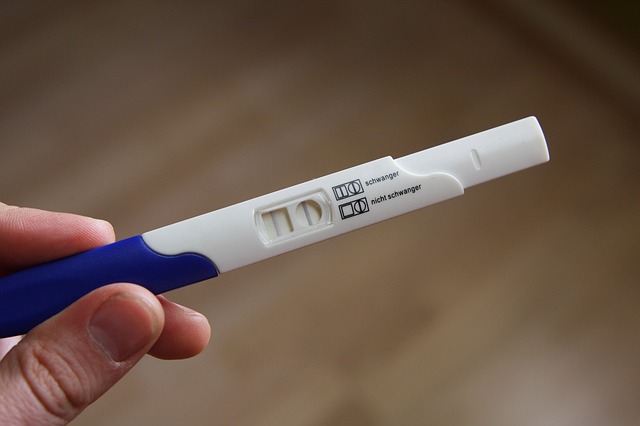
Mommy Science 101: How Do Pregnancy Tests Work?
The earliest known pregnancy test dates back to 1350 BC in Ancient Egypt. According to the Egyptians, all you have to do is urinate on wheat and barley seeds…and wait for the results. It either sprouts, congratulations, you are pregnant!
If wheat spreads faster, it’s a girl, but if barley, then it’s a boy. In 1963, a small study reproduced this test and found that it had predicted pregnancy with a respectable 70% accuracy. However, it couldn’t reliably tell the sex of the baby.
Scientists hypothesized that the test worked because pregnant women’s urine contains more estrogen, which can promote seed growth. In todays’ day and age, it’s easy to take this ancient method for granted because modern pregnancy tests give highly accurate results within minutes. But have you ever asked yourself — how do today’s pregnancy tests work?
Peeing on a Stick: The Beginning of the Many Weird Things You’ll Do as a Mother

Over-the-counter pregnancy tests are all designed to detect one thing — a hormone called HCG. HCG is produced in the earliest stages of pregnancy and starts a game of telephone that tells the body not to shed the inner lining of the uterus that month. As the pregnancy progresses, HCG supports the formation of the placenta, which transfers nutrients from mother to fetus.
The test starts when urine is applied to the exposed end of the strip. As the fluid travels up the absorbent fibers, it will cross three separate zones, each with an important task. When the wave hits the first zone called the “reaction zone,” Y-shaped proteins called antibodies will grab onto any HCG. Attached to these antibodies is a handy enzyme that has the ability to turn on dye molecules — which will be crucial later down the road. Then, the urine picks up all the AB1 enzymes and carries them to the test zone, which is where the results show up. Secured to this zone are more Y-shaped antibodies that will also stick to HCG on one of its five binding sites.
Scientists call this type of test a “sandwich assay.” Why? Well, if HCG is present, it gets sandwiched between the AB1 enzyme and AB2 and sticks to the test zone allowing the attached dye-activating enzyme to do its job and create a visible pattern. If there’s no HCG, the wave of urine and enzymes just passes on by.
Finally, there’s one last stop to make, called “the control zone.” As in any good experiment, this step confirms that the test is working properly. Whether the AB1 enzymes never saw HCG, or they are an extra because Zone 1 is overstocked with them, all the unbound AB1 enzymes that have been picked up in Zone 1 should end up here and activate more dye. So if no pattern appears, that indicated that the test was faulty.
These tests are pretty reliable, but they’re not fail-proof. For instance, false negatives can occur if concentrations of HCG aren’t high enough for detection. After implantation, HCG levels double every two to three days, so it may just be too early to tell. Beverages can dilute the urine sample as well, which is why doctors recommend taking the test first thing in the morning.
On the other hand, false positives can come from other sources of HCG, like IVF injections, ectopic pregnancies, or certain cancers such as uterine cancer or testicular cancer — making it possible for one of these tests to tell a man he’s pregnant.
Listen to Your Body: How to Know if Your Are Pregnant Without Taking a Pregnancy Test
Too scared to take the test, huh? Why don’t you ask your body for some answers? Even though pregnancy tests are the most sought-after option, there are a few ways where our bodies can show us some hints. Let’s see if you have some of them.
Remember, early signs can differ from woman to woman. You may notice these symptoms or even none at all. So don’t worry, continue reading and see if you can relate to some of them.
- Missed Periods
When fertilization occurs in the uterus, it stops releasing eggs, thus menstruation is paused. In most cases, this is the reason women suspect that they are pregnant. Welcome to the wonderful effects of pregnancy, ladies! You are free of blood for whole 9 months! (add a link to the “Effects of Pregnancy” article when published)
- Spotting
When the fertilized egg implants itself on the uterus wall, light bleeding or spotting occurs through the vagina. Spotting can sometimes be accompanied by light cramping, which indicates that the egg has implanted itself along the uterus lining. Welcome aboard!
- Vomiting
Morning sickness — when a woman gets sick right after waking up and ends up vomiting for the slightest reason. It’s caused due to the rising hormone levels and occurs around three weeks after fertilization has occurred. The worst part: it comes without an inch of warning.
- Feeling Full
Very early during pregnancy, women might feel unnaturally full, even after consuming a small amount of food. As the progesterone levels in the body rise, it affects the digestive tract and results in bloating. Pregnant plus bloated? Hooray for us.
- Sensitive Breasts
Another early sign of pregnancy is sore breasts. They become tender and swollen, and the nipples feel tingly at the lightest touch. The nipple color might also turn darker, and there may be small spots around the area. Roger that, time to order bigger size bra.
- Urination
Hormonal changes occur in a woman’s body when she’s pregnant, hence, she feels the need to urinate more frequently. This is due to increased blood circulation and higher levels of water retention in the body. Great, what’s more on the line?
- Headaches
Headaches, by themselves, do not indicate pregnancy, but one needs to be alert if it comes with any of the other symptoms mentioned here. Headaches are common as the first trimester progresses, and continue throughout the second trimester.
- Mood Swings
When pregnant, the change in the woman’s mood is sudden and quick — she might be feeling happy at one moment and irritable the next. When you think about it, it is similar to period moodiness. They occur due to rising levels of hormones but can be reduced by trying to consciously maintain a cheery disposition. How do the hipsters call it — live, laugh, love?
In Conclusion
A combination of the signs above can indicate a pregnancy. Still, the best way to find out for sure whether you’re pregnant or not is at the doctor’s office. The doctors are also looking for HCG, but with tests that are more sensitive and quantitative, meaning they can determine the exact level of HCG in your blood. There are still so many things to learn about the female body. A few minutes can feel like forever when you’re waiting on the results of a pregnancy test. But in that brief time, you’re witnessing the power of a scientific method. That one little stick lets you ask a question, perform a controlled experiment, and then analyze the results to check your original hypothesis. The best part is — you don’t even have to wait until the next harvest!